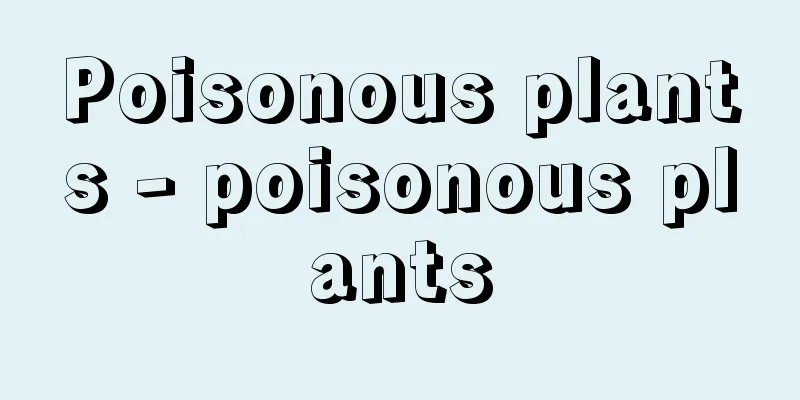Poisonous plants - poisonous plants

|
A plant that contains a toxic substance in part or in its entirety, and in the case of herbaceous plants, it is also called a poisonous plant. Poisonous plants have been known to mankind since ancient times, and have been used as arrow poison, as well as for executions and poisoning. The entire plant of Aconite, which belongs to the Ranunculaceae family, is poisonous, but the seeds and roots are particularly toxic, and the Ainu people used it to poison arrows in whaling and bear hunting. It is said that the Greek philosopher Socrates, who was sentenced to death, died after drinking the broth of Hemlock, which belongs to the Apiaceae family. In Japan, a closely related species, Water Dropwort, grows wild, but in early spring people can mistake it for water parsley and eat it, resulting in death. The young shoots of white clover, a legume pasture plant, and Lotus japonicus contain cyanide glycosides, and there have been cases of livestock dying from feeding on them. When raw green plums are eaten, the ingredients are hydrolyzed by stomach acid, producing hydrocyanic acid in the stomach, which is toxic to the human body, but when processed by salting or other methods, the toxic ingredients are almost completely lost, so there is no need to worry about poisoning. Most of the toxic ingredients in orally poisonous plants are alkaloids (monkshood, tobacco, etc.) or glycosides (oleander, plum, and asebi, etc.), which have a strong bitter taste, but some, such as the toxic ingredients in Deutzia japonica, do not have a bitter taste. There are other poisonous plants that can cause rashes or dermatitis on contact. The stinging hairs that cover the entire plant of nettles contain formic acid, and phenolic compounds are secreted from the bark of sumac trees. All of these are toxic ingredients that can cause rashes. Wind-pollinated pine and cedar pollen are also poisonous to people with allergies. There are about 200 species of poisonous plants that grow wild in Japan, ranging from highly toxic to mildly toxic, and several hundred cases of poisoning are recorded every year. However, many poisonous plants actually have medicinal properties when used in appropriate amounts, so from this point of view, it is difficult to distinguish between poisonous and medicinal plants. Finally, we will list some examples of poisoning symptoms and the main plants that cause them: dizziness (water dropwort, malva oleracea), convulsions (water dropwort, monkshood, monkshood), general paralysis (opium poppy, monkshood), respiratory paralysis (papaveraceae, monkshood, amaryllis, castor bean), and mental confusion (datura, euphorbiaceae). [Akiko Sugiyama] Source: Shogakukan Encyclopedia Nipponica About Encyclopedia Nipponica Information | Legend |
|
植物の一部または全体に有毒な成分を含む植物をいい、草本植物の場合は、毒草ともいう。有毒植物は古くから人類に知られ、矢毒のほか、死刑執行、毒殺などにも利用されてきた。キンポウゲ科のトリカブトは全草有毒であるが、とくに種子と根の毒性が強く、アイヌはこれを捕鯨や熊(くま)狩りの矢毒とした。また、死刑の宣告を受けたギリシアの哲学者ソクラテスは、セリ科のドクニンジンの煮汁を飲んで死んだといわれている。日本には近縁種のドクゼリが野生するが、早春になるとこれをセリと間違えて食し、死亡することもある。マメ科の牧草であるシロツメクサの若芽、ミヤコグサなどには青酸配糖体が含まれており、これを飼料とした家畜が倒れる例もある。青ウメなどを生食すると、含有成分が胃酸で加水分解され、胃の中に青酸を生じるため人体に有毒となるが、塩漬けなどの加工をすると、有毒成分はほとんど失われてしまうので中毒の心配はない。経口的な有毒植物がもつ有毒成分の多くはアルカロイド(トリカブト、タバコなど)や配糖体(キョウチクトウ、ウメ、アセビなど)で、強い苦味があるが、ドクウツギの有毒成分のように苦味のないものもある。有毒植物にはこのほかに接触によってかぶれたり、皮膚炎をおこすものがある。イラクサ類では全草を覆う刺毛にギ酸などを含んでいるし、ウルシ類の樹皮からはフェノール性化合物が分泌される。これらは、いずれもかぶれの原因となる有毒成分である。風媒花のマツやスギの花粉は、アレルギー体質の人にとっては、やはり有毒植物である。 日本に野生する有毒植物は、猛毒から微毒のものまで含めると約200種あり、毎年数百人の中毒事故が記録される。しかし、有毒植物の多くは、適量を用いれば、かえって人体にとって薬効を示すものであり、この観点からすれば、有毒植物と薬用植物との区別はつけにくいといえる。最後に、中毒症状例と、原因となるおもな植物名をあげる。めまい(ドクゼリ、ドクムギ)、けいれん(ドクウツギ、ドクゼリ、トリカブト)、全身麻痺(まひ)(ケシ、トリカブト)、呼吸麻痺(ケシ科、トリカブト、ヒガンバナ、トウゴマ)、精神錯乱(チョウセンアサガオ、トウダイグサ科)。 [杉山明子] 出典 小学館 日本大百科全書(ニッポニカ)日本大百科全書(ニッポニカ)について 情報 | 凡例 |
<<: Embryonic plants - Embryonic plants
Recommend
Proverbs
A book of the Old Testament, it is a representativ...
Pinctada maxima (English spelling)
...The pearl oyster belongs to the family of pear...
Hesychios (English spelling)
Greek historian and literary biographical editor. ...
Temple of Asclepius
...The cult began in the area in the 7th century,...
Sofronie (English spelling) Brachanski Sofronij
1739‐1813 Pioneer of the Bulgarian national reviva...
Building Density
A concept that indicates the amount of buildings o...
Revolutionary base - Kakumeikonkyouchi
...A base for preserving and developing one's...
Beauchamp, KM (English spelling)
…British female writer. Her real name was Kathlee...
Basilisk - Common basiliscus
A lizard of the Iguanidae family of the Squamata ...
Asanoha Maple - Asanoha Maple
A deciduous tree of the maple family (APG classif...
Ferraris, G. (English spelling) FerrarisG
…In 1887, he applied for a patent for a generator...
Apollo 8 - Apollo 8 (English spelling)
The first manned Apollo spacecraft was launched on...
Yokkaichi [city] - Yokkaichi
A city in the northern part of Mie Prefecture, in ...
Ukiyoburo - Ukiyoburo
This is a humorous book written by Shikitei Sanba...
Mount Hanamiya - Kakyusan
…An old temple in Mure-ryo, Suo Province (present...









